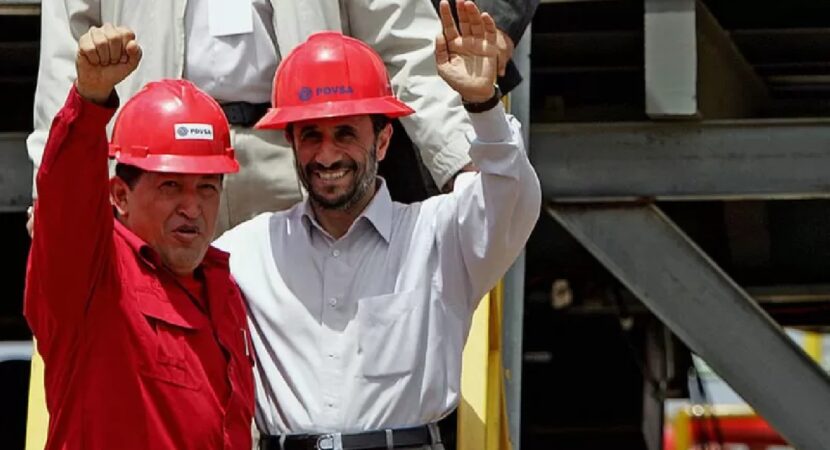
How Iran Is Helping Venezuela Boost Its Oil Production Despite US Sanctions
Venezuela evades US sanctions and allies with Iran. After crude oil production in the neighboring country suffered, in the last two years, a historic setback to levels typical of the mid-twentieth century, in recent months there has been a recovery that took it last November to around 824.000 barrels, almost double of the 434.000 extracted in the same month of 2020.
Read also
- Tension between US and Russia increases and Moscow 'threatens' to take missiles and build military bases in Cuba and Venezuela
- China, the world's biggest oil importer, 'drifts' US sanctions and buys more than 324 million barrels from Venezuela and Iran at a low price
- Oil price soars and exceeds $80 after OPEC+ decides to increase production to 400.000 barrels per day (bpd) in February and the US celebrates
- Venezuela is fighting battles with the United States and Colombia to recover the titles of the oil company PDVSA and not lose its 'chicken that lays the golden eggs'
- In desperation, people in Venezuela steal oil to produce their own gasoline
- Iranian oil tanker loaded with gasoline, bound for Venezuela, “breaks” American barrier in the Caribbean Sea
- Venezuela wants to sell niobium to Russia, making the Government of Brazil go on alert
In an interview broadcast on Venezuelan state television on January 1 of this year, President Nicolás Maduro boasted that the country had managed to produce a million barrels a day again. “This year we reached one million, next year's goal is to reach two million,” said Maduro.
In 1998, before Hugo Chávez came to power, Venezuela produced about 3.120 barrels of crude oil a day, according to OPEC figures.
Although many experts question the number announced by Maduro, they recognize that in 2021 Venezuela managed to recover part of its oil production and point to Iran as a key player in this process.
Key Redemption
“What has been happening is that Venezuela is importing diluents from Iran – naphtha, condensates, light oils – which are being mixed with Venezuelan extra heavy crude. of the Orinoco Belt to increase production,” says José Toro Hardy, an oil economist who was a member of the board of directors of the Venezuelan state PDV
He explains that the oil from that region of Venezuela is very heavy and loaded with a lot of sulfur, so they need to blend it with these products to create a more commercial medium crude.
He points out that Venezuela has produced these diluents in the past, but that this is no longer the case because many oil fields are closed and the country's refineries are working well below capacity.
Toro Hardy indicates that Venezuela, in exchange for these diluents, gives Iran a share of the production of this average crude oil. “This is a trade-off,” he points out.
Iran, like Venezuela, is sanctioned by the United States
“Iran, like Venezuela, is sanctioned by the United States and its oil production has dropped dramatically. Probably that oil that is coming out, let's say, in addition to the sanctions that both Venezuela and Iran have, is doing it in unrecognized tankers, which even turn off the devices so as not to be located on the satellite. This is oil that Iran can trade once it has it in its possession,” he adds.
Tehran has also been helping Venezuela with the shipment of gasoline to supply the domestic market in the Latin American country, where production of this product has declined due to problems at the refinery.
Francisco Monaldi, director of the Latin American Energy Program at the Baker Institute of Rice University (Texas, USA), said that Venezuelan crude oil production is returning to levels seen in early 2020, before Russian oil company Rosneft withdrew. Venezuela and prices plummeted due to the impact of the coronavirus pandemic.
“PDVSA managed, with the help of Iran, to create a sanctions evasion structure replacing Rosneft. In addition, Iran began to supply the thinners that the Russians brought earlier. All this requires high prices to pay intermediaries and cover transportation costs,” Monaldi said in a Twitter thread.
The expert added that the production collapse in 2020 was not the result of a reduction in production capacity, but due to difficulties in selling crude oil at such low prices and avoiding sanctions.
There are a large number of oil wells closed in Venezuela because engines or other equipment have been stolen.
Many oil analysts, including Toro Hardy and Monaldi, agree to question Maduro's announced production value of millions of barrels and predict limitations on its future growth.
“That seems unlikely because, in August, the government itself said we were at 600.000 barrels,” says Toro Hardy in reference to the million barrels.
The specialist guarantees that, when Venezuela managed to increase oil production the most in its history, it was in 1998, when it was immersed in the ambitious oil opening project – which aimed to increase production through partnerships with private capital. That year it increased by 190.000 barrels per day.
“The government's announcement would imply that in four months production increased by 400.000 barrels per day. And that seems unlikely,” he reiterates.
He also highlights that there are currently no active wells in Venezuela, indicating that the country is not drilling new wells. He explains, of course, that PDVSA may be able to increase production by repairing existing wells.
“There are a large number of oil wells closed in Venezuela because engines or other equipment were stolen and that is why they are closed. Repairing them could achieve an increase in production in more or less economic terms, but it would still be difficult to reach the announced 400.000 barrels per day”, says Toro Hardy.
Venezuela has huge oil reserves underground, but tapping them requires big investments and Maduro's plans to increase production to 2 million barrels a day by 2022 look uphill.
Monaldi, for his part, warned that the increases that can be achieved in pumping crude oil at current production capacity are limited.
“It is likely that production is reaching its potential of around 900.000 barrels per day and that additional production will require significant investment in new wells and infrastructure,” he warned in his Twitter thread.
Toro Hardy agrees that, under current conditions, Venezuelan oil production has limited room for growth.
“Venezuela has huge oil reserves underground, but exploiting them requires large investments. It is estimated that, between investments and expenses, recovering production levels 20 years ago would require around US$ 25 billion per year over the next 8 or 10 years”, he says.
“It is very difficult for these amounts to come today from investments made by Iran, Russia or China, because in Venezuela there is a huge lack of legal security that also affects them,” he adds.
So, at least according to these calculations, Maduro's plans to increase production to 2 million barrels a day by 2022 look like an uphill climb.













Air Force F-16 fighters…
True friend, what they shot down were…
Air Force F-16 fighters…
I would like to know what planet you live on…
Air Force F-16 fighters…
Everything is fine, 100-year secrecy,…
Air Force F-16 fighters…
Well... It's flying scrap... Typical...
Air Force F-16 fighters…
Which genocide are you talking about? Than…
I want to sign up now
I want to work with you
If an international competition opens, But…
My dream is to pursue a military career
I am a civil and industrial painter. I have a profession…
This cave wasn’t discovered now, it was…
You don't know what...
They take off their leather there, even more Brazilian…